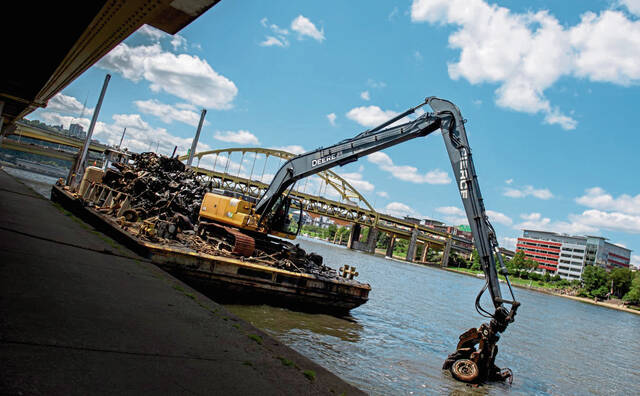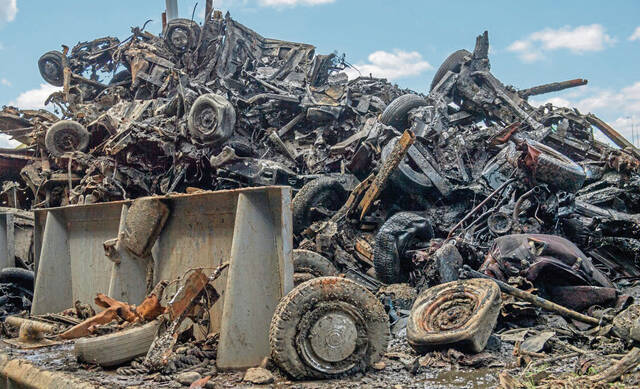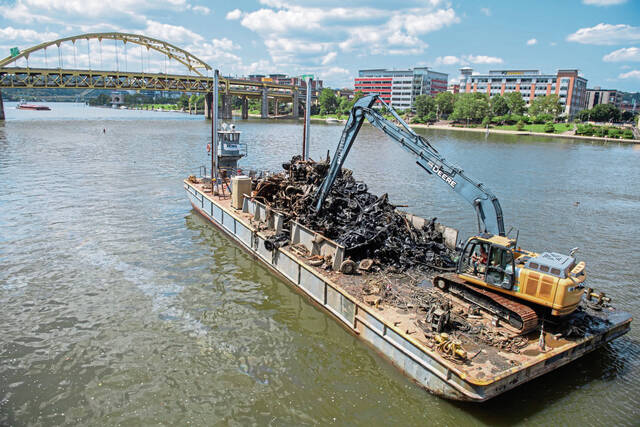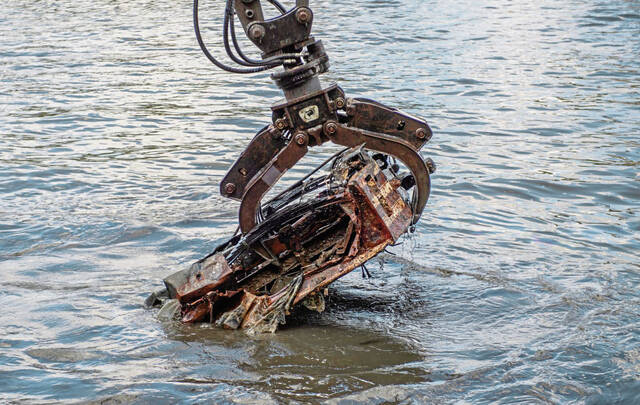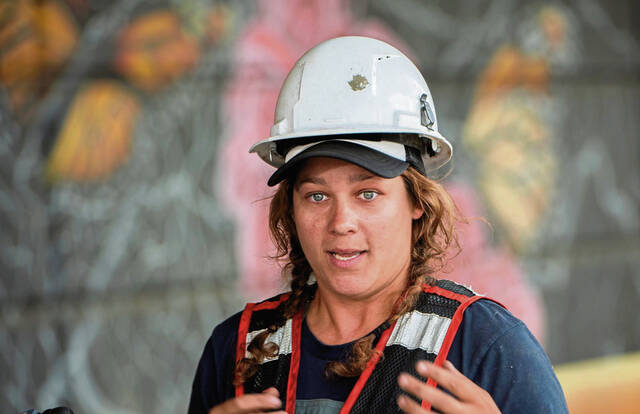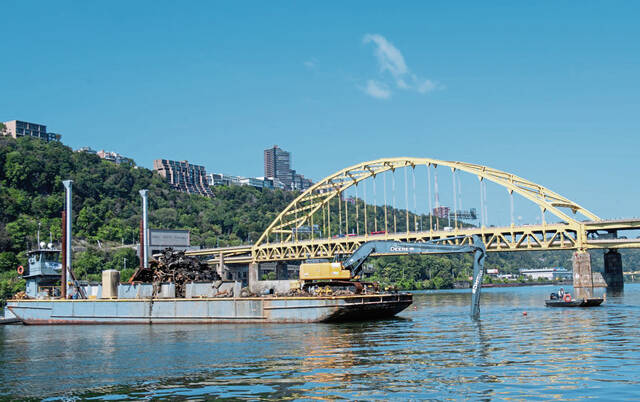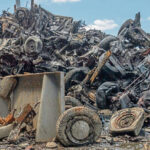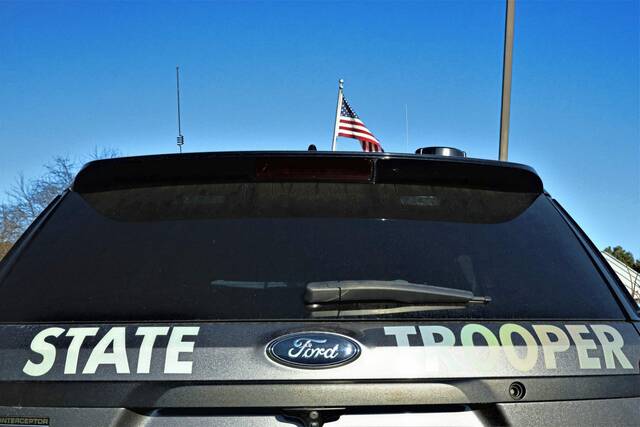The demolition claw — its dirt-brown metal fingers guided by an excavator’s gray 50-foot-long arm — plunged Tuesday afternoon into the cloudy, brownish-green surface of the Allegheny River in search of discarded pieces of Pittsburgh.
Chained to a rusty-bottomed 32-by-120 foot barge, the excavator sent its arm diving over and over — sometimes almost rhythmically — under the surface.
Down it went, probing the murky waters, then up it came, scooping out cars, automobile parts, pieces of metal wreckage.
Plunge, scoop, repeat.
“You’ve just got to go slow and hope it stays together, man,” the claw’s operator, Scott Frederick, said as he smoked a cigarette and sipped Red Bull during a work break. ”Picking up this much stuff this quick — it’s not normal. Usually, we don’t get this much, this fast.”
Frederick, 43, of Cincinnati is a veteran towboat captain working this week with several groups to help clear Pittsburgh’s waterways of decades of debris in what was billed as an “industrial-strength” river cleanup.
Living Lands & Waters, an Illinois-based nonprofit that’s removed more than 13 million pounds of garbage from American rivers, is leading the multi-day effort to remove the sunken vehicles and other trash strewn along the bottom of the Allegheny, Monongahela and Ohio rivers.
Polyconcept North America, a nationwide promotional products supplier with offices in Upper Burrell, is privately funding the work. The groups declined to disclose a project price tag.
Ten divers from Ohio’s Hamilton County Police Association, which previously helped Living Lands & Waters pull 14 vehicles from the Ohio River near their native Cincinnati, mined the Monongahela on Tuesday for sunken, silty treasure.
By mid-morning, they offered the excavator a number of targets, marking them with lines tied from floating white, plastic milk jugs and red buoys the size of soccer balls to rotting debris as far as 20 feet down.
Parts of up to 100 vehicles are submerged — their hoods, axles and tires a knotted mess tangled up below the surface.
Frederick deftly guided the claw. It moved smoothly, its swings and pivots mimicking a dancer’s limbs, as Frederick grabbed chunks of debris and dumped them atop a barge’s growing pile of stinky, blackened detritus.
Parts of the vehicles — what was left of a passenger-side door, remnants of a chassis, a rusted mass resembling a muffler — often slipped back into the river.
The pile of debris behind Frederick smelled pungent, even acrid — vaguely salty, like the ocean, but also rotten and sour.
On Monday, the first day dredging, cleanup crews had pulled some 50,000 pounds of debris, the equivalent of dozens of cars, out of the Allegheny.
By 2 p.m. Tuesday, the second day of the cleanup effort that focused at the confluence Downtown, the barge’s soot-black pile of gnarled metal weighed nearly double.
That’s the weight of about 35 vehicles — 10 of which the group pulled from the Allegheny River in just 30 minutes.
Most of the debris will be recycled at area scrapyards.
“In all the years I’ve been doing river cleanup around here, Pittsburgh’s really now going through a cultural change around the value of the rivers,” said Capt. Evan Clark, 47, wearing a baseball cap and shirt adorned with the logo of his employer, Three Rivers Waterkeeper.
“I think it tells a story, pulling these cars out of the river,” Clark said.
How they got there
The dredging, which will continue into next week, started with a sonar screen.
Back in May, Clark partially mapped the floors of Pittsburgh’s three rivers using a side-scan sonar screen slightly larger than a cellphone.
The technology sends and receives acoustic pulses to detect objects submerged in water, according to the National Oceanic and Atmospheric Administration.
Its frequencies paint pictures with light and shadow. Hard objects protruding upward send strong echoes and create a dark image. Softer areas, like mud and sand, send weaker echoes, creating brighter accents.
Under ideal conditions, Clark said, a car’s make and model can be determined through sonar.
There’s no consensus on how cars end up at the bottom of Pittsburgh’s rivers.
Some might have been stolen or taken on joyrides, then pushed off riverbanks, said Callie Schaser, 28, of East Moline, Ill., a Living Lands & Water spokeswoman.
Schaser remembers when her group’s excavator — which can lift 10,000 pounds and is nicknamed “the game-changer” — removed a car from the Ohio River near Kentucky with a brick still on the gas pedal.
Others posit that the cars hail from a long-defunct Downtown parking lot that washed the vehicles into the Allegheny River during flooding.
The way the vehicles crumple when pulled out of the rivers indicates they were made in the 1960s or earlier, some doing the dredging said.
“A lot of them were from crimes. And a lot of them were stolen,” said Kelly Williford, 46, of Westchester, Ohio, an assistant commander with the Hamilton County dive team, as he stood between the Mon Wharf parking lot and the nearby riverbank. “They’ve been there so long that people have forgotten about them.”
Lots of mattresses
Pittsburgh’s waterways aren’t just home to scores of mid-century vehicles.
On Friday, Pittsburgh River Rescue divers conducting routine training in the Allegheny found a drone that had fallen in during a recent show at PNC Park.
On occasion, human remains are discovered.
On June 30, a dive team found a body when they recovered a vehicle submerged in the Allegheny River near Butler Street in Springdale.
It happened again July 21, across that same stretch of the Allegheny, when the body of a missing woman was found off the Oakmont shore in one of the two cars removed that day.
Last year, authorities retrieved an unoccupied car from near the Springdale Marina — a Yugo, last manufactured in 2008.
Frederick couldn’t put his finger on the weirdest thing he’s recovered from the 10-odd rivers where he’s worked with Living Lands & Waters.
He’s never found human remains.
Mattresses, though, are a different story. Frederick said that he’s found at least one in every river where he’s worked.
While Frederick employs some tricks of the trade — such as swinging larger vehicle parts into the lip of the barge to break them apart — he said there’s no exact science to his work.
Part of the river
Many of those now dredging Pittsburgh’s rivers are deeply connected to the country’s waterways.
Though Frederick has worked for 28 years as a towboat captain, he grew up along the Ohio River and started his journey there at age 16 as a ferryboat deckhand.
“Me and the river — I’m just part of it,” he said, smiling as he walked on the barge in mud-stained boots.
Schaser, a Wisconsin native who went to college in Illinois, has spent much of the past few years living on river barges.
After joining Living Lands & Waters, she helped collect 1.2 million pounds of debris in rural Kentucky, which had been decimated by a tornado shortly after the covid-19 pandemic. She later lived on a barge while cleaning the Ohio River in Louisville.
“The physicality of it really drew me in — you know, not sitting at a desk all the time,” Schaser said as she stood near the South Side Public Boat Launch in a faded orange life vest, sunglasses and leather cowboy boots. “It’s easy to be passionate about it because the results are incredible.”
Clark, who grew up in Michigan, lived and traveled from 1999 through 2006 in home-built boats up and down the Mississippi, Ohio and Tennessee rivers. Today, he vacations on houseboats. Once the dredging is done, Clark plans to sail boats in Canada.
‘Fantastic stories’
Ken Behrend is a landlubber, growing up in the densely packed streets of Pittsburgh’s Oakland neighborhood.
Like many river voyeurs, the Pittsburgh-based attorney stopped Tuesday along Fort Duquesne Boulevard during his regular walk Downtown to watch the excavator’s methodical work.
“Who would think this many automobiles were in the river?” Behrend, 65, of Wexford said as the excavator plucked a fender — its silver still shining — from the Allegheny.
“These vehicles, and how they ended up in the river,” Behrend said, “there’s got to be fantastic stories there.”


